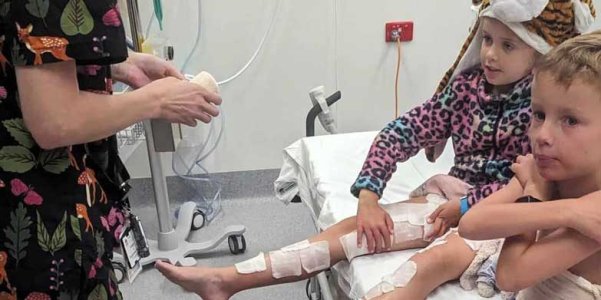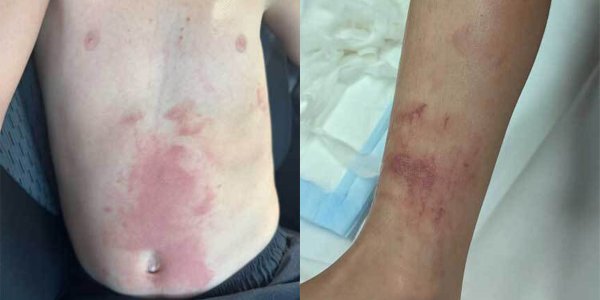A sour slice of reality: Mum's ‘terrifying ordeal’ unveils hidden dangers of everyday fruit
- Replies 4
In a tale that reads like a cautionary fable for the modern parent, a mum's harrowing experience has sent ripples of concern through communities across Australia.
Felicity Frankish, a mum and editor for the North Shore Mums website, has bravely come forward to share a 'terrifying ordeal' that left her daughter and a friend's son with severe, painful rashes.
This incident has shone a spotlight on the hidden dangers lurking in our everyday lives, particularly in the seemingly innocuous fruit we often handle without a second thought.
The ordeal began innocently enough on Easter Sunday when Felicity's eight-year-old daughter, Cassie, complained of a burning sensation in her fingers.
‘She often gets niggles that pass as quickly as they come,’ Felicity recalled.
However, her concern grew as the pain persisted.
‘'It wasn't until we were sitting on a ride at the Sydney Family Show four hours later, and she had tears in her eyes that I knew this was serious,’ she narrated.

By the time they returned home, Cassie's legs were covered in a spreading rash, accompanied by intense pain.
Felicity promptly contacted their friend who had been with them the previous day to inquire if their son Max was also encountering a similar situation.
They said no at first, but shortly after, Max also developed a rash.
The families initially suspected a contact rash from playing in bushes and treated the children with antihistamines.
‘As we researched, the pain was getting worse and blisters had started to appear,’ Felicity recounted.
‘By the hour we were watching blisters appear on our kids' skin with no idea what was causing it.’
After a visit to the GP and a misdiagnosis of contact rash treated with steroids, Felicity took to the internet in search of answers.
‘As I came across phytophotodermatitis, also known as a “margarita burn”, everything made sense. It was the limes,’ she determined.
The day before the symptoms appeared, Cassie and Max had been squeezing limes, inadvertently covering themselves in the juice.
The red rash was identified as burns covering their legs, fingers, and Max's stomach, resulting from contact with the limes.
‘Lime contains furocoumarins, a class of chemicals in some plants and fruit, which when exposed to sunlight can cause sensitivity and burn,’ Felicity explained.
‘Something so innocent was actually so dangerous.’

They promptly rushed the children to the hospital emergency department as their discomfort intensified and required proper medical attention.
However, once again, both children were diagnosed with a contact rash and were prescribed steroids, as medical professionals dismissed the possibility of margarita burns.
Despite this, Felicity persisted and implored one of the doctors to further investigate the matter.
‘After what felt like an eternity, the doctor returned, convinced, and began treating the burns, and asked us to come back as outpatients the next day,’ she narrated.
However, by the next morning, the number of blisters had increased, and both Cassie and Max were experiencing excruciating pain.
Opting for a different hospital in hopes of avoiding the lengthy wait they encountered previously, the parents had to recount the margarita burn incident all over again to the nurses and doctors.
Subsequently, the medical staff reached out to Westmead Children's Hospital, received appropriate guidance, and tended to the children's wounds, offering some much-needed relief.
Nevertheless, the journey toward recovery was far from over, prompting the families to seek further treatment at the Westmead Burns Unit.
‘It was there that Cassie and Max finally received the care they needed. The skin, blistered and painful, was carefully treated and wrapped,’ Felicity said.
‘This experience was a wake-up call for me. Something as simple as playing with limes in the backyard led to such a terrifying ordeal.’
She also intended to share this incident to other parents, ‘hoping it can prevent a similar situation, and educate others about the hidden dangers that can turn an innocent day into a nightmare’.
‘We had no idea citrus could cause this or never would have let our kids play with the limes, and would love to spread awareness,’ Felicity asserted.
She also noted that their decision to seek treatment at multiple hospitals was entirely their own choice, and ‘all of them were really helpful and we have zero issues with the treatment at any step of the process’.
As the dangers of margarita burns come to light, it's crucial for everyone to take precautions when handling certain fruit.
This was highlighted by a similar incident that happened to another kid last year.
Whether it's squeezing limes and other fruit for a refreshing drink or simply enjoying them by themselves, it's essential to be aware of the risks involved.

Have you or someone you know ever experienced a similar reaction? Share your stories and tips for staying safe in the comments below.
Felicity Frankish, a mum and editor for the North Shore Mums website, has bravely come forward to share a 'terrifying ordeal' that left her daughter and a friend's son with severe, painful rashes.
This incident has shone a spotlight on the hidden dangers lurking in our everyday lives, particularly in the seemingly innocuous fruit we often handle without a second thought.
The ordeal began innocently enough on Easter Sunday when Felicity's eight-year-old daughter, Cassie, complained of a burning sensation in her fingers.
‘She often gets niggles that pass as quickly as they come,’ Felicity recalled.
However, her concern grew as the pain persisted.
‘'It wasn't until we were sitting on a ride at the Sydney Family Show four hours later, and she had tears in her eyes that I knew this was serious,’ she narrated.

Felicity Frankish shared an incident that happened to her daughter and her friend’s son to educate other parents. Credits: North Shore Mums / Felicity Frankish
By the time they returned home, Cassie's legs were covered in a spreading rash, accompanied by intense pain.
Felicity promptly contacted their friend who had been with them the previous day to inquire if their son Max was also encountering a similar situation.
They said no at first, but shortly after, Max also developed a rash.
The families initially suspected a contact rash from playing in bushes and treated the children with antihistamines.
‘As we researched, the pain was getting worse and blisters had started to appear,’ Felicity recounted.
‘By the hour we were watching blisters appear on our kids' skin with no idea what was causing it.’
After a visit to the GP and a misdiagnosis of contact rash treated with steroids, Felicity took to the internet in search of answers.
‘As I came across phytophotodermatitis, also known as a “margarita burn”, everything made sense. It was the limes,’ she determined.
The day before the symptoms appeared, Cassie and Max had been squeezing limes, inadvertently covering themselves in the juice.
The red rash was identified as burns covering their legs, fingers, and Max's stomach, resulting from contact with the limes.
‘Lime contains furocoumarins, a class of chemicals in some plants and fruit, which when exposed to sunlight can cause sensitivity and burn,’ Felicity explained.
‘Something so innocent was actually so dangerous.’

Injuries on Max’s stomach and Cassie’s leg due to margarita burn. Credits: North Shore Mums / Felicity Frankish
They promptly rushed the children to the hospital emergency department as their discomfort intensified and required proper medical attention.
However, once again, both children were diagnosed with a contact rash and were prescribed steroids, as medical professionals dismissed the possibility of margarita burns.
Despite this, Felicity persisted and implored one of the doctors to further investigate the matter.
‘After what felt like an eternity, the doctor returned, convinced, and began treating the burns, and asked us to come back as outpatients the next day,’ she narrated.
However, by the next morning, the number of blisters had increased, and both Cassie and Max were experiencing excruciating pain.
Opting for a different hospital in hopes of avoiding the lengthy wait they encountered previously, the parents had to recount the margarita burn incident all over again to the nurses and doctors.
Subsequently, the medical staff reached out to Westmead Children's Hospital, received appropriate guidance, and tended to the children's wounds, offering some much-needed relief.
Nevertheless, the journey toward recovery was far from over, prompting the families to seek further treatment at the Westmead Burns Unit.
‘It was there that Cassie and Max finally received the care they needed. The skin, blistered and painful, was carefully treated and wrapped,’ Felicity said.
‘This experience was a wake-up call for me. Something as simple as playing with limes in the backyard led to such a terrifying ordeal.’
She also intended to share this incident to other parents, ‘hoping it can prevent a similar situation, and educate others about the hidden dangers that can turn an innocent day into a nightmare’.
‘We had no idea citrus could cause this or never would have let our kids play with the limes, and would love to spread awareness,’ Felicity asserted.
She also noted that their decision to seek treatment at multiple hospitals was entirely their own choice, and ‘all of them were really helpful and we have zero issues with the treatment at any step of the process’.
As the dangers of margarita burns come to light, it's crucial for everyone to take precautions when handling certain fruit.
This was highlighted by a similar incident that happened to another kid last year.
Whether it's squeezing limes and other fruit for a refreshing drink or simply enjoying them by themselves, it's essential to be aware of the risks involved.
Key Takeaways
- A Sydney mum warned parents about the dangers of phytophotodermatitis, also known as 'margarita burns', caused by lime juice in sunlight.
- Her daughter and a friend's son suffered severe skin reactions, characterised by painful burns and blisters, after playing with limes.
- Initial diagnoses as contact rashes were incorrect, leading to delays in proper treatment for the children's actual condition.
- The experience prompted the mother to share her story to raise awareness of the risks associated with citrus fruit and sunlight exposure.
Last edited:







